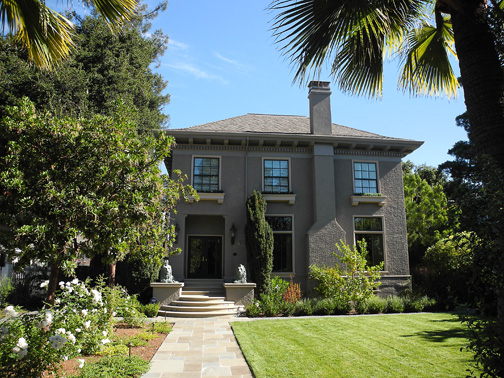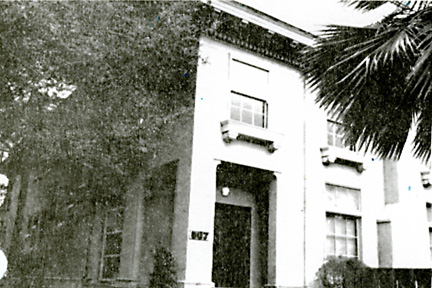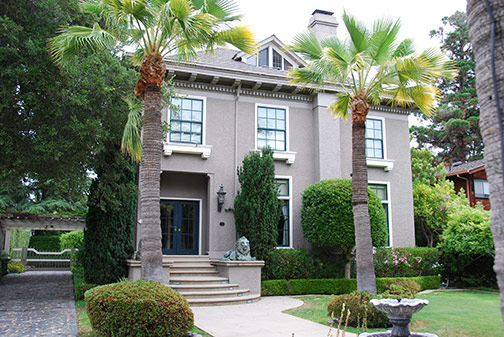 Palo Alto Stanford Heritage
Palo Alto Stanford Heritage 
This 5,718 square foot residence was built at 1001 Hamilton Avenue for Mary Lincoln and Walter Danforth Tobey. Because of a lot subdivision in 1966, the original side entrance on Hale became the front entry. The house is a restrained yet elegant example of Classical Revival architecture. It is unadorned except for a few touches of careful, classically derived ornament. The dentil and brackets under the eaves are an appropriately strong statement for a house of such substantial character.

The structure, which is concrete over outsized beams, was technically advanced for its time. Built at a cost of $18,000, even by today’s standards, it is a mansion. The interior displays a large variety of stunning woods to which the owner had access, as he had accumulated his fortune in the Nevada lumber business supplying lumber to the Comstock mines. The living room is trimmed in white cypress, the magnificent reception hall in redwood. Pilasters line the walls. Square columns frame the massive staircase and the three leaded glass windows on the side of the house rise with the stairs. When the sun shines through the amber glass, the reception hall is radiant. Originally, the site had a barn with four rooms for servants in addition to the loft and stable. Behind it was a tank house whose details were not neglected by the architect. A grape arbor used to extend from one side of the house and a large verandah for entertaining from the other.
The architect, William Danforth Bliss, born in Nevada in 1873, was Mr. Tobey’s nephew. His father, Duane Bliss, was a partner in a Nevada Bank which was purchased by Darius Ogden Mills, President of the Bank of California. Mills and Duane Bliss went on to form the Carson and Tahoe Lumber and Planing Company. This secured the Bliss family fortune enabling the son, Walter Danforth Bliss to attend MIT. There he met his future architecture partner, William Baker Faville. From 1895 to 1898, Bliss and Faville worked for the prestigious New York firm of McKim, Mead and White, where they were imbued in Beaux–Arts Classic Revival architecture. Moving to San Francisco in 1898, the two young men started their own firm. They used Duane Bliss’ connections to secure commissions. Theirs was one of the City’s most prolific partnerships, designing residences in Pacific and Presidio Heights including the Flood Mansion and many landmark buildings such as the St. Francis Hotel and the Corinthian–columned Bank of California. The 1904 Hale Street house was their first use of reinforced concrete construction. After the 1906 earthquake, Bliss and Faville often used this type of construction in San Francisco. Bliss died in 1956.

The Tobey family lived at 567 Hale Street until 1926. From 1930 to 1935, it was the home of George McKaig, a businessman whose son William was a very active supporter and fund-raiser for community and regional activities relating to outdoor life. Subsequent owners installed life-size bronze lions, cobblestone driveway, the new arbor, the gate and the concrete steps and walkway. Despite these exterior modifications, the Tobey House maintains its status as a Category 2 house on Palo Alto’s Historic Inventory. ©
PAST, October 19, 2012; updated April 7, 2018.
| |
E-mail us at either webmaster@pastheritage.org or president@pastheritage.org.
![]() Palo Alto Stanford Heritage—Dedicated to the preservation of Palo Alto's historic buildings.
Palo Alto Stanford Heritage—Dedicated to the preservation of Palo Alto's historic buildings.
Copyright © 2015 Palo Alto Stanford Heritage. All rights reserved.